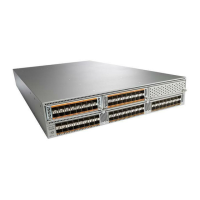Send documentation comments to n5kdocfeedback@cisco.com
2-5
Cisco Nexus 5000 Series NX-OS Interfaces Operations Guide, Release 5.0(3)N2(1)
Chapter 2 Cisco Nexus 5500 Platform Layer 3 and vPC Operations
vPC Peer Link Failure
The delay restore feature allows you to configure a timed delay before vPC member ports are brought
online. The delay allows the switch to learn all routes, to bring up the vPC member ports, and to forward
traffic from hosts. The following example shows how to configure a timed delay of 120 seconds:
layer3-switch(config-vpc-domain)# delay restore ?
<1-3600> Delay in bringing up the vPC links (in seconds)
layer3-switch(config-vpc-domain)# delay restore 120
layer3-switch(config-vpc-domain)#
vPC Peer Link Failure
In addition to suspending vPC member ports, the vPC secondary switch also suspends its switched
virtual interface (SVIs) when a vPC peer link is lost. When this occurs, the vPC secondary switch stops
advertising the local subnets, which prevents traffic blackholing.
Layer 3 Module Failure
When a Layer 3 module fails on a Cisco Nexus 5500 Platform switch all Layer 3 interfaces are
suspended, including Layer 3 port channel and SVI interfaces. As a result, the Layer 3 routing table on
the neighboring routers is updated which results in the north to south traffic to be directed towards the
peer Nexus 5500 Platform switch. The Layer 2 interfaces, including the Layer 2 port channel and
out-of-band management interfaces, remain up.
In a non-vPC topology, when the Layer 3 and SVI interfaces are down, the redundant Cisco Nexus 5500
Platform switch becomes the active peer for all FHRP groups and it continues to forward traffic.
In a vPC topology, although the SVI interfaces are suspended, the vPC member ports are still up on the
Cisco Nexus 5500 Platform switch. Even if the switch has a faulty Layer 3 module, Layer 2 traffic
forwarding continues.
Figure 2-5 shows a topology where the Layer 3 module on N5k-2 fails. In this scenario, the Layer 3
connection toward the Layer 3 network and all SVI interfaces are suspended. However, the traffic from
the hosts can still be sent to N5k-2 depending on the hash results. With the failure of the Layer 3 module,
N5k-2 functions as a Layer 2 switch. It forwards the traffic to N5k-1, which forwards the traffic to the
Layer 3 network. The return traffic is sent to N5k-1, which sends the traffic directly to the hosts.

